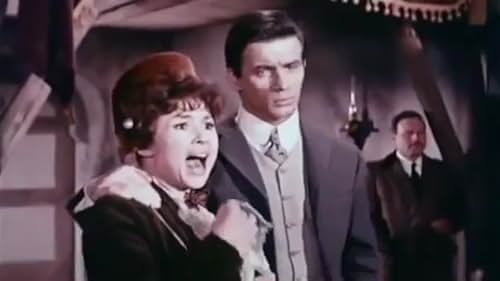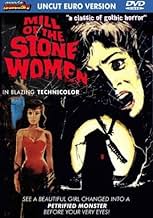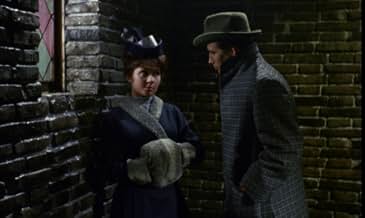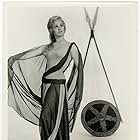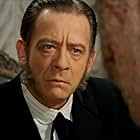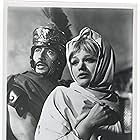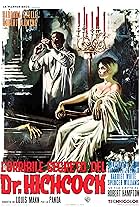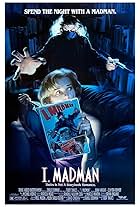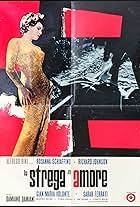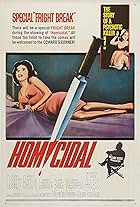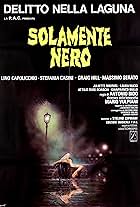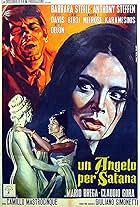IMDb RATING
6.5/10
2.2K
YOUR RATING
In 19th century Holland, a professor of fine arts and an unlicensed surgeon run a secret lab where the professor's ill daughter receives blood-transfusions from kidnapped female victims who ... Read allIn 19th century Holland, a professor of fine arts and an unlicensed surgeon run a secret lab where the professor's ill daughter receives blood-transfusions from kidnapped female victims who posthumously become macabre art.In 19th century Holland, a professor of fine arts and an unlicensed surgeon run a secret lab where the professor's ill daughter receives blood-transfusions from kidnapped female victims who posthumously become macabre art.
Dany Carrel
- Liselotte Kornheim
- (as Danny Carrell)
Herbert A.E. Böhme
- Il professore Gregorius Wahl
- (as Herbert Boehme)
Storyline
Did you know
- TriviaThough the credits state that the film is based on a short story by Pieter van Weigen (from the book Flemish Tales), no such author exists.
- GoofsA mummified corpse would never spontaneously pop it's top, not to mention separate head and body on a perfectly clean line, as Annie Laurie's does.
- ConnectionsReferenced in Xenes se xeni hora: 50 ellinikes tainies mystiriou kai fantasias (2009)
Featured review
Without question an inappropriate, inane, or pulpy comic book style title has waylaid many a significant and otherwise worthy terror film. "Curse of the Cat People," remains affixed to a story of child psychology, "Kill Baby Kill," remains affixed to a wondrous 19th century European ghost story, and here, perhaps worst of all, "Mill of the Stone Women," is the awkward moniker stuck to this artistically accomplished film.
With a clunky title like "Mill of the Stone Women," it is scarcely any wonder that the film has remained largely unknown,unremarked upon, and unavailable for nearly 50 years ! What a pity, for here is a story produced with such an aesthetically accomplished loving care that each frame breathes a compositional beauty of the highest standard.
The felicitous combination of Arrigo Equini's art direction and Pier Ludovico Pavoni's photography in this picture, recalls the best of Jack Asher, Floyd Crosby, Mario Bava, Bernard Robinson, and Daniel Haller and has, in not a few of the tableaux rendered here, even surpassed these masters. Even Mario Praz would probably approve!
From the opening shot of the windmill on the lake under a leaden sky, to its shadowy, beautifully appointed interior parlors, complete with the anti-heroine, Scilla Gabel, peaking mournfully through the portières--while the soundtrack gives forth with a disquieting numinous wail--the film rarely fails to sound the genuine Gothic note.
Add to that one of the most disturbing, (far more so than "House of Wax") use of a waxworks yet seen on the screen. For here we have, not merely figures of unsettling visage, but figures that mechanically encircle a stage--Joan of Arc, Cleopatra, Mary Queen of Scots, sallying threateningly towards the camera in a nightmarish parade--all to the accompaniment of a tune that might have been composed by Truman Capote! There are many exquisite scenes to savor: Miss Scabra's blood red boudoir, a scene of her beneath the lid of a dusty glass coffin holding yellow roses against her very dead, old ivory like complexion, a laboratory sequence that pulls out all the stops, a charming stop at a beer garden type pub, complete with accordions and pretzel stands, a climactic fire with the dummies melting in grotesque close-ups, not to mention a beautifully costumed, very accomplished, and handsome cast of players.
Miss Gabel seems very much in the Gina Lollobrigida mold, but manages facial expressions of such uncanny yearning that is easy to imagine Mr. Brice falling under her spell. In this sense, she joins company with Barbara Steele, as one of the very few women able to combine beauty and eeriness in equal measure.
Pierre Brice approaches his assignment with convincing earnestness and looks very much like a cross between Stephen Boyd and Horst Buchold.
A special compliment should be paid to the Technicolor here, which never shrieks, but delivers cold blues and unearthly reds in a fashion that favorably recalls Pressburger's "Tales of Hoffmann." And take a good look at the hutch in the ante-room of Mr. Brice's bedroom; it is the same one featured in Jacqueline Pierreux's parlor in Bava's "Black Sabbath"--the one she keeps her liquor in. Perhaps Mr. Brice had a yard sale! In any case, to fans of the genre, this film is highly recommended.
With a clunky title like "Mill of the Stone Women," it is scarcely any wonder that the film has remained largely unknown,unremarked upon, and unavailable for nearly 50 years ! What a pity, for here is a story produced with such an aesthetically accomplished loving care that each frame breathes a compositional beauty of the highest standard.
The felicitous combination of Arrigo Equini's art direction and Pier Ludovico Pavoni's photography in this picture, recalls the best of Jack Asher, Floyd Crosby, Mario Bava, Bernard Robinson, and Daniel Haller and has, in not a few of the tableaux rendered here, even surpassed these masters. Even Mario Praz would probably approve!
From the opening shot of the windmill on the lake under a leaden sky, to its shadowy, beautifully appointed interior parlors, complete with the anti-heroine, Scilla Gabel, peaking mournfully through the portières--while the soundtrack gives forth with a disquieting numinous wail--the film rarely fails to sound the genuine Gothic note.
Add to that one of the most disturbing, (far more so than "House of Wax") use of a waxworks yet seen on the screen. For here we have, not merely figures of unsettling visage, but figures that mechanically encircle a stage--Joan of Arc, Cleopatra, Mary Queen of Scots, sallying threateningly towards the camera in a nightmarish parade--all to the accompaniment of a tune that might have been composed by Truman Capote! There are many exquisite scenes to savor: Miss Scabra's blood red boudoir, a scene of her beneath the lid of a dusty glass coffin holding yellow roses against her very dead, old ivory like complexion, a laboratory sequence that pulls out all the stops, a charming stop at a beer garden type pub, complete with accordions and pretzel stands, a climactic fire with the dummies melting in grotesque close-ups, not to mention a beautifully costumed, very accomplished, and handsome cast of players.
Miss Gabel seems very much in the Gina Lollobrigida mold, but manages facial expressions of such uncanny yearning that is easy to imagine Mr. Brice falling under her spell. In this sense, she joins company with Barbara Steele, as one of the very few women able to combine beauty and eeriness in equal measure.
Pierre Brice approaches his assignment with convincing earnestness and looks very much like a cross between Stephen Boyd and Horst Buchold.
A special compliment should be paid to the Technicolor here, which never shrieks, but delivers cold blues and unearthly reds in a fashion that favorably recalls Pressburger's "Tales of Hoffmann." And take a good look at the hutch in the ante-room of Mr. Brice's bedroom; it is the same one featured in Jacqueline Pierreux's parlor in Bava's "Black Sabbath"--the one she keeps her liquor in. Perhaps Mr. Brice had a yard sale! In any case, to fans of the genre, this film is highly recommended.
- BrentCarleton
- Feb 15, 2006
- Permalink
Details
- Runtime1 hour 36 minutes
- Sound mix
- Aspect ratio
- 1.66 : 1
Contribute to this page
Suggest an edit or add missing content

Top Gap
By what name was Mill of the Stone Women (1960) officially released in India in English?
Answer
